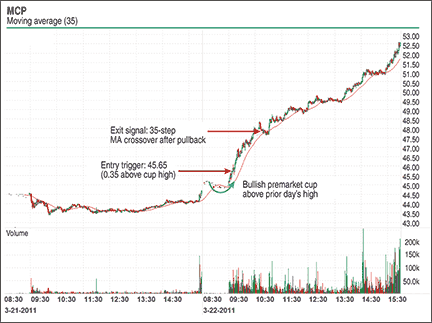INDICATORS
A Strategic Approach
Daytrading Cup Breakouts
Here’s how you can daytrade momentum trades.
Entering and exiting intraday trades using precision technical trading signals has been popular with both retail and institutional traders, since it limits overnight risk exposure. The primary elements of professional daytrading include scanning for volatile breakouts during the first hour of the trading day, setting specific technical entry signals to initiate new trades, and using careful risk management to scale in and out of positions once they’re initiated. Daytrading stocks, eminis, forex, and exchange traded funds (Etfs) all require different entry and exit signals.
The two-day high stock cup entry
The strongest entry pattern in daytrading equities is relatively simple. Entries are set using new high price breakouts roughly at 0.35 or so above the prior day’s highs during the first hour of the market open, following a cup breakout above a 35-step (as in, 35-period) moving average (MA) crossover on a two-day, one-minute chart on high volume.
In this intraday breakout in Molycorp Inc. (Mcp) in Figure 1, you can see that a bullish cup was formed between 44.7 and 45.3 during the premarket, slightly above the prior day’s high. A long entry signal is generated at 0.35 above the cup high at 45.65, with the exit generated when the price action crossed back under the 35-step MA at 47.8.

Figure 1: Molycorp Inc (MCP) Daytrade. Here you see long breakout signals indicated by an entry trigger 0.35 above premarket cup high on a two-day high continuation pattern.
The chart setup is a one-minute, two-day chart with the time set to display data from 7 am to 4 pm Eastern time. The reason for showing so much premarket data is to be able to see gaps, cup patterns, and trends (with volume) before the start of the trading session. Focusing on premarket price action helps successful daytraders develop a specific price-based entry strategy for trading once the market opens. It is usually not a good idea to enter new positions premarket because of wide spreads and lower liquidity.